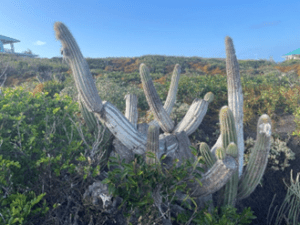TAG: GS 3: ECOLOGY AND ENVIRONMENT
THE CONTEXT: The Key Largo tree cactus (Pilosocereus millspaughii) has become the first recorded plant species in the United States to go extinct due to rising sea levels, highlighting the severe impact of climate change on biodiversity.
EXPLANATION:
- This unique cactus, discovered about three decades ago in North America, once thrived in the Florida Keys, a region highly susceptible to sea-level rise and storm surges.
The Habitat and Vulnerability of the Key Largo Tree Cactus
- The Key Largo tree cactus was known to exist in a single population in the Florida Keys, an area characterized by low-lying land, much of which is less than five feet above sea level.
- The species also exists on a few scattered islands in the Caribbean, including northern Cuba and parts of the Bahamas.
- The cactus’ habitat in the Florida Keys has been increasingly inundated with saltwater due to rising sea levels, which rose by approximately 0.21 meters between 1971 and 2022, at an average annual rate of 4.09 millimeters.
- This saltwater intrusion, exacerbated by hurricanes and high tides, led to soil depletion and made the environment uninhabitable for the cactus.
Decline and Extinction of the Key Largo Tree Cactus
- Timeline of Decline
- 1998: The cacti survived Hurricane Georges.
- 2005: The population was not significantly impacted by a series of four hurricanes.
- 2013-2015: A significant decline was noted, with the population reducing by 50%, leaving only 60 live individuals by 2015.
- 2016: Only 28 rooted stems remained, indicating a further 50% reduction.
- 2021: The team found only six ailing fragments, which were rescued for off-site cultivation.
- 2022-2023: No healthy material was found in 2022, but a small, rooted fragment regrew to approximately 35 cm in 2023 and was rescued.
- Factors Contributing to Extinction
- Worsening storm surges and increased sea levels were likely responsible for the dramatic decline post-2015.
- Herbivory also played a role, as animals dealing with water scarcity targeted the cacti, which store water in their stems.
Ecological and Environmental Implications
- Impact on Local Biodiversity
- The extinction of the Key Largo tree cactus serves as a warning for other low-lying coastal plants.
- The Florida Keys have experienced 19 named hurricanes since 2000 and an increase in “king tides,” which are unusually high tides causing prolonged flooding.
- This has led to saltwater encroachment and habitat loss, threatening other plant and animal species in the region.
- Broader Implications of Rising Sea Levels
- According to NASA, global sea levels have risen by 103 millimeters since 1993 due to melting ice sheets and the thermal expansion of seawater.
- A 2013 report by the Center for Biological Diversity found that 17% of the nation’s threatened and endangered species are at risk from rising sea levels.
- These species include the Key deer, Loggerhead Sea turtle, Delmarva Peninsula fox squirrel, Western snowy plover, and Hawaiian monk seal.
Key Largo tree cactus (Pilosocereus millspaughii)
- Pilosocereus millspaughii is a species of flowering plant in the family Cactaceae, native to Florida, The Bahamas, Cuba, Haiti, and the Turks and Caicos Islands.
- It was first described by Nathaniel Lord Britton in 1909 as Cephalocereus millspaughii.
- It is now locally extinct in Florida due to sea level rise.
- It is a shrubby to arborescent, branched succulent which can reach heights of up to 7 m.
- The main stem is 20 cm wide, and the branches are 15 cm wide.
- The fragrant, cream-coloured flowers smell like garlic.


